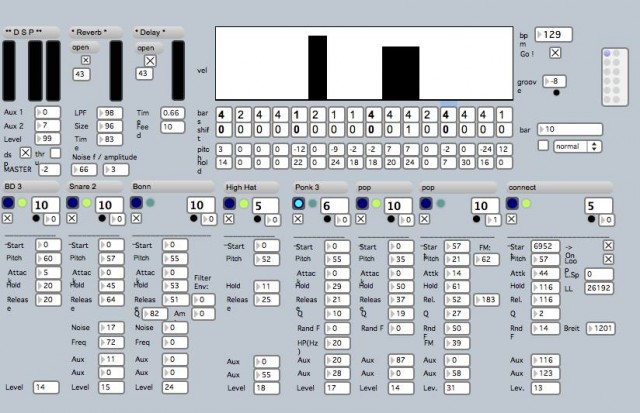This is what a Monolake live set sounded like in 1999. And in the days before Ableton Live was a finished product, running patterns was a job for self-built software in Max.
Robert describes the music thusly:
This is a live recording, captured at Ego club in Düsseldorf, June 5 1999. The music has been created with a self written step sequencer, the PX-18, controlling a basic sample player and effects engine, all done in MaxMSP, running on a Powerbook G3. The step sequencer had some unique features, e.g. the ability to switch patterns independently in each track, which later became an important part of a certain music software.
I found the recording on a backup disk today. It has not been edited or mastered. During the first 20 minutes of the set, and before the ‘encore’ the Monolake CD ‘Gobi’ is playing in the background.
What strikes me about this is that both the music and the patch hold up nicely a decade and a half later.
You can see the Max patch at top. You’ll notice those are modern widgets; Robert just opened it in the newest version of Max. But the software, too, endures. And embedded in the constraints of this patch are some of the kind of formal restrictions Robert imposes on his music. With a fixed number of parts on tracks, the sonic materials sound like a consistent ensemble — the shapes of the sounds shifting over time, but still discrete, recognizable objects.
The thought also occurs that there’s still value in working this way today, even with Live as a choice. You could certainly load this sort of pattern maker into Live with Max for Live. But you might also put together a different kind of performance if you channeled your musical ideas into this kind of DIY creation.
I’ll be talking tonight about that topic at Coding the Club here in Amsterdam; I’ll share some notes on that presentation afterward.
By the way, I will quote Robert from a previous discussion on his site of Ableton Live, so as not to bring an old myth back to life:
According to an old myth Live is based on a MAX patcher. This would be completely impossible to do! What is true, is that before there was Live, there were MAX patches and Reaktor ensembles by Gerhard and me that did a lot of things we both found interesting, like timestreching beat loops, or a sequencer that allowed to switch between individual patterns for each instrument in real time.
From: http://monolake.de/technology/ableton_live.html
Actually, what isn’t impossible is to build a small subset of functionality from Live into Max or Pd, and that can also be an interesting exercise. (Or throw that back into Max for Live and … well, have not really many limitations at all!)
